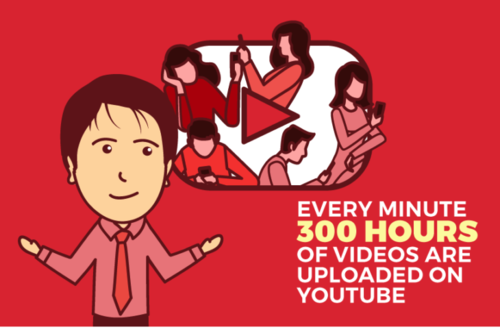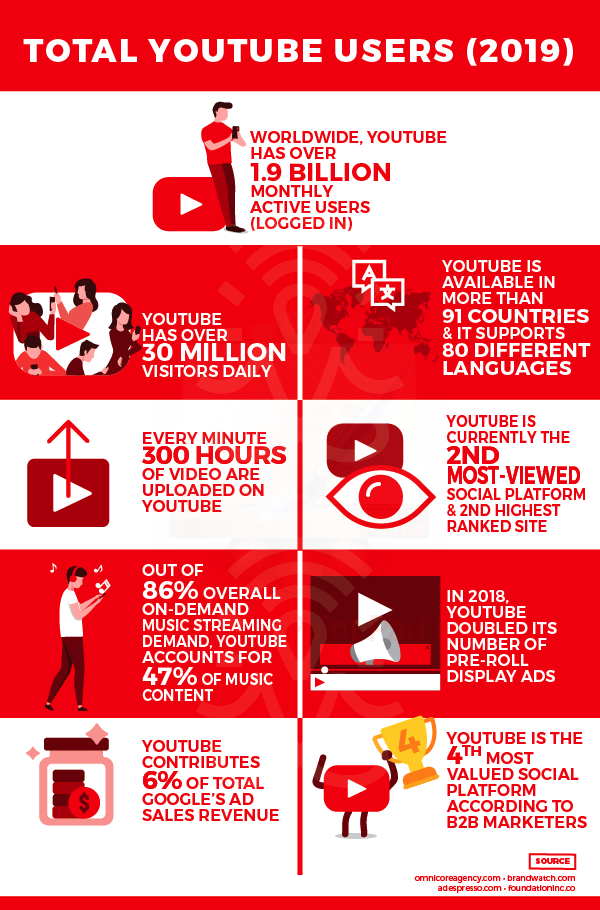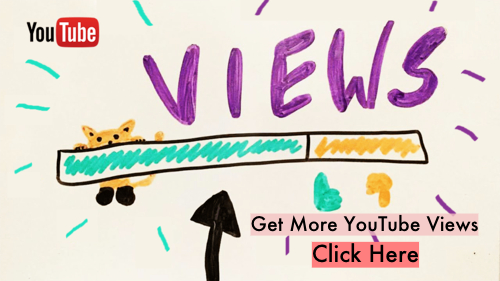
YouTube is one of the hardest platforms on which to grow quickly and on which to go viral. Similar to Instagram, it’s not set up as an inherently shareable platform. Similar to SEO, the goal is to rank well enough within YouTube’s algorithms to get your content filtered to the top of search results and to be included in suggested viewing.
Jackie Koppell, principal on-camera talent and creator at NewsyNews and recently chosen by YouTube for the inaugural Women in Comedy program, is also the former head of talent at AwesomenessTV, a multiplatform media company. Koppell explains that twenty thousand subscribers is the minimum amount you need to get the algorithms to pay attention to you, fifty thousand subscribers to start making money, and a hundred thousand subscribers to get brands to pay attention to you.
She says that one strategy for growth is to leverage the viral and rapid growth potential of Facebook to build a large audience and then drive those fans to follow your YouTube channel. Once you establish rapid growth on Facebook, it becomes easier to push people to your YouTube channel.
Watch Time Is King
With YouTube’s algorithms, watch time is king, so the percentage of time that people watch your videos is more important than how many people view them. Success is contingent upon creating great, high-quality content that people want to watch for a long time and upon utilizing strategic collaborations that help you grow.
Unlike on any of the other platforms, longer content does really well on YouTube. Joivan Wade, founder of “The Wall of Comedy!” explains that people will actually come to the platform to watch long pieces of content. An eight-minute video seems like an optimal amount of time and will be very well received (if it’s good).
Erick Brownstein of Shareability says that his team thinks YouTube is particularly valuable for the long haul because content lives there forever and is easily searchable. If your content is solid, it can get picked up in other places as well and you can start to build organically.
Content Discovery and Growth
People typically discover content in three ways:
1 – Everyone starts sharing your content and it goes viral
The best way, but extremely hard to make happen on YouTube since it’s not an inherently shareable platform.
2 – Through search
If you hit metadata and trends that people are already searching, it’s a great way to get discovered.
3 – Through other people’s content
Which is a big reason collaborations come in handy.
Jonathan Skogmo, CEO of Jukin Media and creator of the YouTube channel FailArmy, with more than 14 million subscribers, has had major success. In fact, when “Gangnam Style” was the number one most watched video in the world, Skogmo’s company had the second most watched video, “The Ultimate Girls Fail Compilation 2012.” “Gangnam Style” had four hundred million views in November 2012, and “Ultimate Girls Fail” had 290 million. Skogmo shares that his company has seen YouTube make all sorts of changes in their algorithms based on users’ behaviors and reactions.
If you’re a content creator, you must be agile enough to make quick changes and tweaks as YouTube changes. Study the platform and continuously pay attention to what does well. This goes back to the idea of testing and learning, although being searchable is always going to be one of the keys to growth.
Chris Williams, the founder and CEO of pocket.watch and former chief audience officer of Maker Studios, where he oversaw more than sixty thousand channels, says that the best way to grow on YouTube is a combination of paid media, collaborations, optimizations, and playlisting. He’s a big believer in using paid media to lead to organic growth. He adds that follow-on views—the amount of content people watch after the initial video they’re driven to—is the truest indication of organic growth coming off paid media expenses.
He uses AdSense to track which videos his viewers watch. His team determines the effectiveness of a piece of content by how much more content it gets people to consume. This indicator dictates their strategy and influences how his team uses paid media to fuel growth. It gives them insight into both the content and the marketing strategy.
Jackie Koppell adds that she has seen people grow quickly with giveaways. When she was at AwesomenessTV she saw people give away fancy cameras or iPads. If you can do that consistently (which she realizes most people can’t) your numbers start to skyrocket!
 |
| YouTuber Desk Setup example |
Collaborations Lead to Quick Organic Growth
One of the best ways to build a community on YouTube is through collaborations with other YouTubers. Sharing audiences isn’t a novel concept—it’s something that people have been talking about for the last ten years—but it really does work. Your collaborators’ biggest fans will subscribe to everyone in the collaboration group.
Phil Ranta, the former COO of Studio71, one of the largest influencer-driven digital entertainment companies, has used strategic partnerships to grow YouTube influencers’ followings. His team has done a lot of work with Rhett & Link (4.6 million subscribers), who collaborate with TV host Jimmy Fallon.
Rhett & Link created “Good Mythical Morning,” a YouTube talk show. Rhett & Link and Fallon’s shows have similar styles but reach different audiences. Fallon has an older, more traditional fan base, and Rhett & Link have a younger, scrappier fan base. To collaborate and share audiences, they started appearing on each other’s shows.
Fallon does episodes of “Good Mythical Morning,” and Rhett & Link make appearances on The Tonight Show. It has been really advantageous for both parties. Working with Fallon has brought Rhett & Link to the mainstream, while at the same time has helped Fallon break into the digital world.
Collaborations also work well for people who are just starting. Ranta has seen people start out time and again with only ten subscribers and then generate more than two hundred thousand new fans a week through collaborations. Growth from optimal collaborations can happen swiftly on YouTube. For example, Ranta was running channel partnerships at Fullscreen when YouTube personality Shane Dawson was in the network. During this time, he observed that Dawson was an expert collaborator who could launch careers. He watched Dawson take smaller creators under his wing and collaborate with them in a bunch of videos; oftentimes they’d become huge stars even before they started posting their own videos aggressively. Dawson’s collaborations have helped internet personalities like Shanna Malcolm and Alexis G. Zall increase their fandom.
When starting out, you don’t have to collaborate with someone of Shane Dawson’s size. Even if the person you collaborate with only has ten thousand subscribers, there’s a chance that three hundred of their fans will start following your YouTube channel. And if you have zero to a hundred subscribers, start collaborating with someone who has a thousand. Work your way up the ladder.
Chris Williams agrees that strategic partnerships and collaborations are vital for scale and growth. His team feels that they’re an extraordinarily efficient means of creating a “conference of cool.” Essentially, they allow the audience to find and like you because you’re associated with something they already gravitate toward.
Collaborations drive a direct audience in a fairly efficient way. Additionally, Ranta has noticed that a lot of YouTubers move to the same apartment complexes in L.A. to make it easier to collaborate. Apparently, a lot of the top social influencers have lived in the Hollywood and Vine building at some point (tough luck for the neighbors who aren’t YouTubers).
However, Koppell points out that you don’t want to prematurely move to L.A. just for this reason. Exhaust the connections that you can make from your hometown first. And if you have at least ten thousand subscribers, you can film at the YouTube offices in major cities all over the world, including Los Angeles, New York, Paris, and London (YouTube Space), one day a month free of charge, which is a great way to make connections and start meeting people. Do as much networking as you can before moving so the transition is easier if and when you do decide to move.
Focus Your Efforts and Frequency
Ranta believes that to build a solid audience on YouTube, you should focus most of your efforts on the content creation for that channel. He doesn’t suggest that you ignore other platforms while building an audience on YouTube but says that you’re better off making five YouTube videos rather than two YouTube videos, two Facebook posts, and a podcast. He explains that size begets growth, so an optimal strategy is to make the bulk of the content on YouTube and then use the other social platforms to engage with fans and promote YouTube video views. When people put their main effort into YouTube, he sees them get more total subscribers than when they try to build everything at once.
Also, if you create good YouTube content daily, it’s amazing for your growth. Ranta says that the fastest way to grow is to take more swings, and the way to take more swings is to make more videos.
Frequency is really important for building an audience, especially when you’re starting out. Of course, you shouldn’t put up content you don’t like, but if you’re a vlogger and only post once a week, it’s really hard to keep up with people who post every day. Fans are there every day, so if you vlog four times in a row and then you’re not there for a few days, people will start forgetting about you.
Have a Strong Point of View and Stick to One Theme
Ranta believes the number one thing that every successful YouTube creator has in common is a strong point of view around which they consistently create content. Their point of view could be related to their comedic sense of humor, makeup style, or fitness ideas, but they have to have something that makes them unique.
Once you recognize what sets you apart, highlight that attribute or theme on your channel. If you keep at it, you’ll usually find success. This is more important than looking good on camera or having a lot of experience as a vlogger. Ranta has observed that even those with great skill usually don’t achieve success if they don’t stick to one topic. Changing topics too often becomes very confusing for people.
Approach your content from a single point of view and you’ll have a better chance of finding your audience. When you review YouTube comments, you’ll see that the videos and channels people love most are ones that make them feel like they’re connecting with their best friends. It’s really hard to feel like someone is your best friend if you can’t explain what they’re about. Keep it simple and start with a narrow focus.
Two-Way Conversations
YouTube offers people a community and a place to go and speak with others. One of the biggest differences between the success of social stars and traditional movie or television stars is that the social content creator is perceived like they’re talking to their friends, while the movie or television star is more distant. A social star is inspirational, while a movie star is aspirational.
Ranta explains that when you’re a vlogger or a personality, there’s a preexisting expectation that the audience is watching someone who could potentially be their friend or interact with them. The audience loves the idea that they can be mentioned in a comment. Some reasonably big creators do have one-way conversations—like basic how-tos or Vivo channels. However, those work because they’re enjoyed more like television, where comments are less important. But if your goal is to be a YouTube personality or a host, then the two-way conversation is vital.
Passion and Knowledge
Ranta shares that you’re doing the wrong thing if you don’t love what you’re talking about. People who succeed on this platform are extremely passionate about the topics of their videos. And since there’s such an open market, there’s an audience for almost everything, as long as you’re creating cool content.
There are some deep cultures online. For example, if you’re into superheroes or comic books, there are a lot of fanatics out there. You must really know what you’re talking about to make a channel like that work. Ranta explains that if you’re someone who goes home and thinks, “Marvel stuff is popular. I’ll be a Marvel commentator,” but you’re not actually an expert, people will smell your inauthenticity immediately and the content will flop.
Make sure that you’re knowledgeable and passionate about the topic you discuss on your channel. This authentic passion is what people respond positively toward. Plus, you’ll enjoy learning everything about something you love. It will help you stay motivated and give you fuel to put in the necessary effort to create a channel that thrives.
Be the Same but Different
To start generating an audience on YouTube, you need to follow the basic content patterns and trends. You usually can’t come out of nowhere with content that’s totally unfamiliar. The biggest thing Ranta always tells people is to be the same but different. Your style needs to be recognizable and people need to understand what’s going on, but it needs to be distinct enough that someone will follow you over another vlogger.
Koppell points out that makeup tutorials and gaming channels do really well, and family/kid content is the reigning champion on YouTube. She also explains that a current popular trend to generate more watch time on your channel is to use cues that encourage people to stay. You can say things like, “I can’t wait to tell you guys — I’m gonna reveal my secret surprise at the end of the video.” Or if you’re doing a beauty tutorial, you can say, “Stay till the end of the video, guys, because I’m gonna reveal the entire look.”
Although you should follow the tips mentioned above, you also need to develop your own unique way of doing things. Find your authentic voice and formula. Make sure to bring your distinctive personality and show people who you truly are. There is no one like you and if you bring your whole self to the camera, it will help you shine and gain more YouTube fans.

Viral Machines
Ranta’s company, Studio71, works with Roman Atwood, one of the top social influencers in the world, with more than 15 million subscribers, who has created viral videos that have received more than 4.5 billion views.
Atwood rose to fame from doing viral prank videos and then used that success to create a daily vlog that was more family friendly.
Atwood is a viral machine. He hasn’t just had virals here and there but has had consistent viral videos. A lot of that is because he understands pacing and what makes something clickable or entertaining. He didn’t have to go to acting class or hosting school. Once Atwood started doing pranks online, he just had a way with the camera, and he is good looking, young, and energetic.
Ranta explains that he read an interesting article about Michael Phelps and why he’s such a successful swimmer. Apparently, Phelps was born with an enlarged heart and had noticeably webbed fingers—it’s as though he were born to be a swimmer. Ranta feels that many YouTube stars are famous for the same reasons—it’s as if they were engineered in a lab to be perfect YouTubers. Ranta says that the people who do well listen and learn.
Chris Williams agrees that personality is a big indicator of how successful one will be on YouTube. But to do further analysis, his team studied Ryan’s World (formerly Ryan ToysReview), the largest YouTube creator channel in the world and also a partner of Chris’s company, to try and determine some of the attributes that led to the channel’s phenomenal growth. According to BBC, in 2019, alone the eight-year-old host, Ryan, has made $26 million in revenue from his YouTube account. An eight-year-old boy who reviews toys has been named as the highest earning YouTuber, for the second year in a row. (Quite a lucky kid, since he gets to live many children’s dreams of getting paid to play with and review toys on the channel.)
Williams feels that much of Ryan’s success is because he appears multicultural. This concept was brought to his attention while watching an interview with Dwayne “the Rock” Johnson, where he was asked about his popularity. The Rock explained that he thinks that many people resonate with him because they believe they share his nationality and ethnicity. They think the Rock “is their thing” because he relates to a lot of different ethnic communities. Williams says that Ryan has a similar appeal. He sees that being perceived as multicultural is a rewarding attribute on YouTube. He also thinks that Ryan’s mom’s infectious laugh (as she is the one who holds the camera) has contributed to the channel’s success. And, of course, the selection of content and toys that Ryan reviews contribute to his success.
Koppell adds that the greatest influencers work hard. As easy as it is for people to diminish what influencers do, the reality is they are good at what they do—there’s something about them that people want to watch. They consistently put up content and put themselves out there adapting with the times. She finds this respectable and valuable.
Value in Multichannel Networks
Multichannel networks (MCNs) collaborate with video platforms like YouTube to offer assistance to channel owners in areas like digital rights management, programming, funding, partner management, audience development, product, cross promotion, monetization, or sales in exchange for some of the channel’s advertising revenue.
The decision to join a network on YouTube is based on where you are in your career and where you want to go. MCNs can be extremely helpful, but they’re like signing with any agent or manager—you don’t want to be at the bottom of anyone’s roster. You don’t want to be in a one-size-fits-all situation that doesn’t suit your brand’s needs.
For example, Ranta explains that if an MCN offers you access to a tech platform where you’ll get deep data and analytics, you can make better decisions, but if you’re not overinterested in deciphering data and analytics, it’s probably not the right MCN for you. However, if you’re ready to package and sell your own television show, and it’s an MCN that has a track record of success in that area, perhaps pursuing it could be highly valuable.
Reaching Kids and Analyzing Metrics
Williams shares that if your audience demographic is kids and families, YouTube is great because it’s “where kids live.” Over 70 percent of children’s video content consumption is done on streaming platforms. And YouTube dominates in terms of watch time with kids. It’s been his company’s primary platform for growth as they cater to this demographic.
When working with kids, your metrics are not related entirely to the number of subscribers you gain, since children are too young to subscribe. Instead, his team focuses on the strategy of optimizing for algorithms that allow them prominent placement inside suggested and related videos. They usually pay attention to metrics like watch time and follow-on views (how many other videos a viewer views after the initial video) to judge the effectiveness of their tactics.
Going Viral
Filmmaker and CEO/creative director at Comp-A Productions, Pedro D. Flores, who personally has more than 298K subscribers and the viral hit “Tacos” has over 100 million views, explains that going viral is always a roll of the dice. You can put in all the right recipes for the perfect viral video, but you honestly never know if it’s going to be successful.
He never thought that the parody video “Tacos,” about the fact that he is a non-Mexican-looking Mexican, would go viral. That success changed his whole perspective on the type of content he wanted to create. Before that video, he had never made anything about his ethnicity. But after seeing how well the audience responded, he now caters to that niche. You won’t start out knowing what works for you.
You will discover your viewers’ tastes by creating content, testing, and learning—sound familiar? Flores says that you have to constantly shift. And he would know. Flores has been on the YouTube platform since the very beginning. He created early viral sensations “Kings of Myspace” and “Kings of YouTube”. He was also the director and frequent collaborator of a lot of YouTube stars, such as Timothy DeLaGhetto (4 million subscribers) and SUPEReeeGo’s Eric Ochoa (3.3 million subscribers). He’s also successfully transferred his channel from having content only in English to being a channel with all content in Spanish. Then he shifted from a Spanish channel using real people to one using mostly cartoons.
You have to be willing to change with the times and go with the trends. He says that if you don’t keep up, you will get left behind.
Quick Tips and Recap
• On YouTube you need to have at least twenty thousand subscribers for algorithms to respond, fifty thousand subscribers to start making money, and a hundred thousand subscribers to get brands to pay attention.
• Currently, YouTube’s algorithms favor content with a high percentage of watch time. Longer content does well on YouTube.
• YouTube is one of the most difficult platforms on which to achieve rapid growth.
• Growth happens primarily through algorithms, search, and collaborations.
• Be consistent and put out content daily.
• Collaboration is key to rapid growth on YouTube.
• Move to Hollywood and Vine to find YouTube collaborators. Just kidding (sort of).
• If you have ten thousand subscribers, you can film at the YouTube offices one day a month, free of charge.
• Determine the effectiveness of a piece of content by how much more content it gets people to consume.
• Use AdSense to track which videos people view.
• Analyze your metrics by way of subscribers, watch time, and follow-on views depending on your needs.
• Have a strong point of view in your content and on your channel.
• Stick to one topic or viewpoint on your channel.
• If your goal is to be a personality or a host, then the two-way conversation with your fans is important.
• Be passionate and knowledgeable about your topic.
• Be the same but different in your approach to topics and content creation style.
• Makeup tutorials, gaming channels, and family-friendly programs reign supreme on YouTube.
• Use cues to encourage people to stay and watch your content.
• Feature your fans in your vlogs to gain their interest.
• Work hard, be flexible, and adapt as the platform changes.

